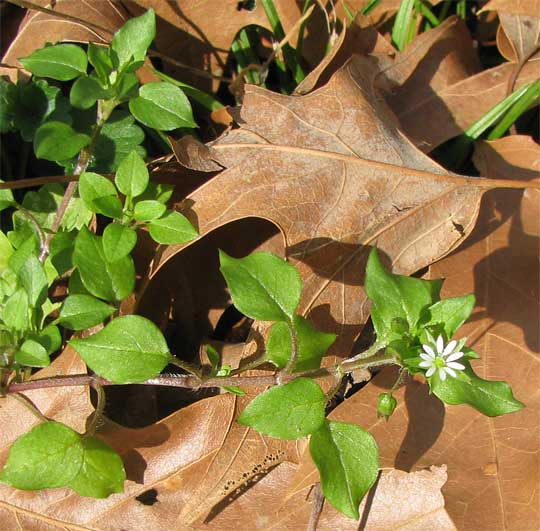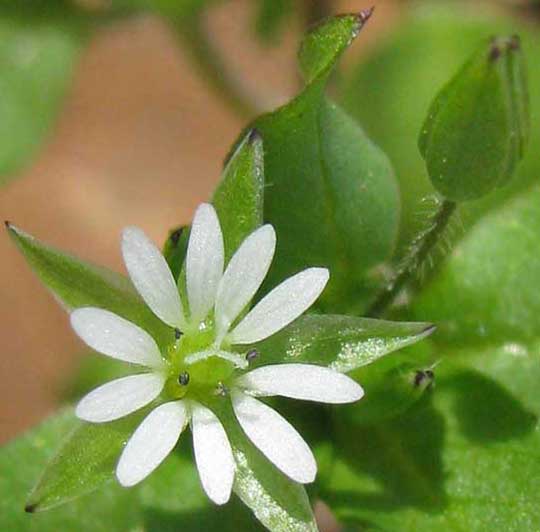Excerpts from Jim Conrad's
Naturalist Newsletter
from the February 9, 2009 Newsletter, issued from the forest near Natchez, Mississippi; elevation ~400ft (120m), ~N31.47°, ~W91.29°:
CHICKWEED FLOWERING
Last week I reported that the most conspicuously flowering plant in Karen's backyard was the Ivy-leaved Speedwell. Farther north in most suburban-type places I suspect that that honor will be claimed by the Common Chickweed, STELLARIA MEDIA, shown below:

Despite Common Chickweed being an invasive from Eurasia I'm especially fond of the species because of memories from my young-naturalist days back in Kentucky. In February or March, after a long winter aching to return to the flower-studying business, this modest little plant usually was the season's first offering. Typically flowering plants would show up at the base of buildings' south-facing walls and on sunny but probably still-cold days I'd go sit in the grass there, ceremoniously bring out my dog-eared Gray's Manual of Botany and, even though I already knew what it was, savor every dichotomy in the Manual's technical identification keys.
"Fruit a 1-seeded utricle" or "Fruit a several-many- seeded capsule," the key would ask. "Many-seeded capsule" I'd whisper to myself, and advance to the next question, marveling at how pretty and delicate a "many-seeded capsule" was glistening in brilliant winter sunlight.

Above you can see a close-up of a Common Chickweed flower about the width of a BB. The flower's design is very simple with the spherical, green ovary nestled in the blossom's center, topped by a white, Y-shaped style. Little stamens arise between white petals, the stamens' tiny, dark, oval, pollen-producing anthers barely visible atop their greenish filaments, and all this is subtended by the green, star-shaped calyx. This flower comes pretty close to the super-simple, super-average "Standard Blossom" used to teach flower anatomy at http://www.backyardnature.net/fl_stand.htm.
However, there's one spectacular difference: The blossom's five white petals are all so deeply cut down their middles that they're V-shaped. At first you think the flower bears ten petals but if you look closely you can see that each of the FIVE petals is deeply cut from the top, with each lobe barely connected at the base.
Deeply cut petals are typical features of the chickweed's family, the Caryophyllaceae, usually known as the Pink Family. In fact, the "Pink" in the family name instead of referring to a color refers to the root word in "pinking shears." Members of the Pink Family often have "pinked," or deeply cut, petals.
The old herbals speak of the Common Chickweed as having a lot of medicinal uses. It's "tonic, diuretic, demulcent, expectorant, and mildly laxative." If you have a cold you might brew up a greenish tea of it, making sure you're not picking any doused with pesticides or auto exhausts. Also it's reported to be good for skin problems. I find chickweed tea to be tolerable, at least if served hot. I've drunk a good bit of it without seeing any affects, good or bad, but I'm seldom sick so I'm not a good tester for it.